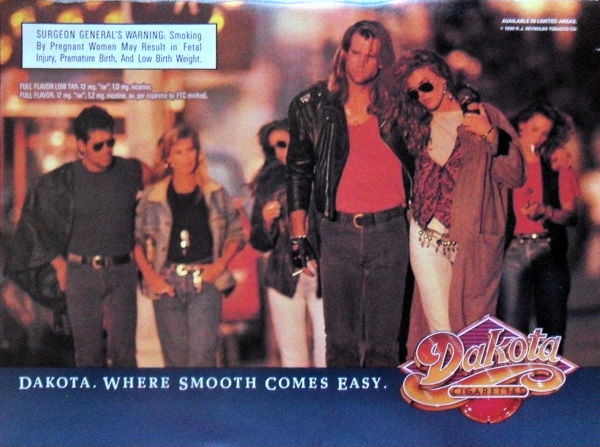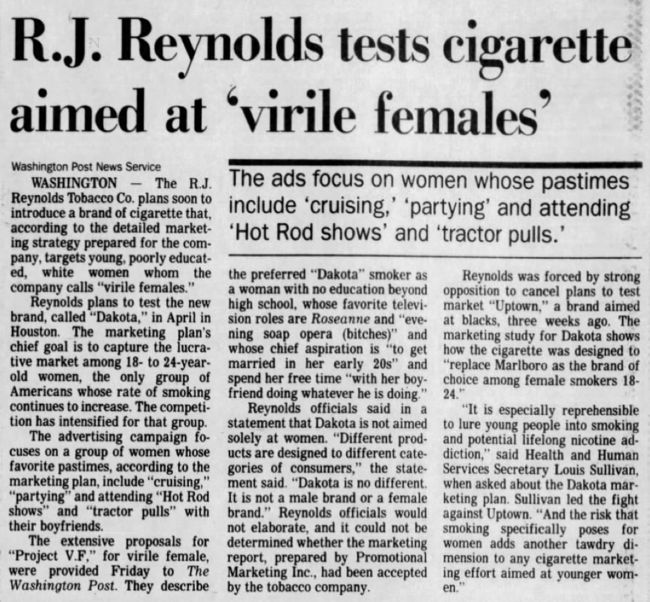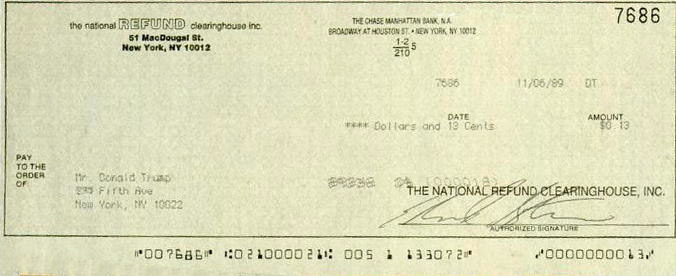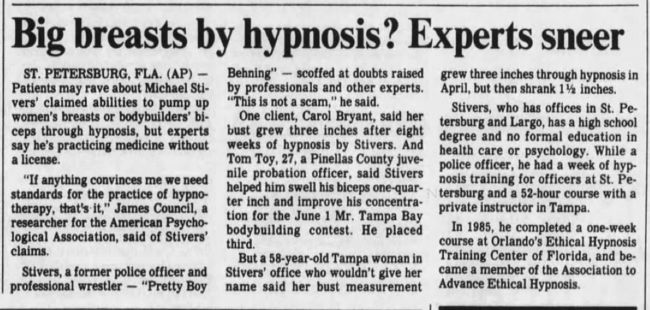1990s
Dakota Cigarettes for the Virile Female
In 1990, R.J. Reynolds test marketed a new brand of cigarette named "Dakota." But the brand immediately generated controversy when internal company documents leaked to the Washington Post revealed that the cigarettes were narrowly targeted at a demographic described as "virile females."What exactly is a "virile female"? It was apparently "a woman with no education beyond high school, whose favorite television roles are Roseanne and 'evening soap opera (bitches)' and whose chief aspiration is 'to get married in her early 20s' and spend her free time 'with her boyfriend doing whatever he is doing.'"
The phrase "virile female" attracted a lot of interest. Many people wondered if it was acceptable English. Language columnist William Safire weighed in on the issue, asking, "Can you use virile woman without committing an oxymoronic act?" He concluded, yes you can:
He further noted that there was literary precedent for the phrase:
However, even though Safire had officially approved the phrase "virile female," the cigarettes themselves didn't perform well in the test marketing, so Reynolds scuttled the brand.



Palm Beach Post - Feb 17, 1990
Posted By: Alex - Thu Nov 10, 2016 -
Comments (6)
Category: Products, Smoking and Tobacco, 1990s
The Silence of the Hams
Posted By: Paul - Sat Oct 22, 2016 -
Comments (3)
Category: Ineptness, Crudity, Talentlessness, Kitsch, and Bad Art, Movies, Homages, Pastiches, Tributes and Borrowings, 1990s
Staged shooting as motivational stunt
November 1993: As high school football coach Dale Christensen was giving a pep talk to his players in the school cafeteria, hours before a game, a fight broke out between two students and Christensen moved immediately to intercede.Then shots rang out. Christensen fell to the ground, blood spreading across his shirt. Christensen's son (who was a player on the team) shouted, "My dad's been shot!" Panic erupted, and people started running, seeking cover from the shooter.
But a few seconds later, Christensen jumped back up and announced he was okay. The shooting had been fake — staged as a stunt to motivate the players.
Unfortunately for Christensen, he had a hard time getting anyone to understand why the fake shooting was motivational. He later noted, "people in general outside the football team... do not understand what he was trying to accomplish."
School officials definitely didn't understand. The team lost the game, and a few days later Christensen was forced to resign.
Reminds me of that coach who arranged for his players to view a bull castration before a game as a "motivational experience." When asked how it was motivational, he replied, "That's everybody's different perception."

St. Louis Post-Dispatch - Nov 25, 1993
Posted By: Alex - Thu Oct 20, 2016 -
Comments (1)
Category: Sports, 1990s
Earrings on a deer
Bettie Phillips' fifteen minutes of fame involved her decision to put earrings on a baby deer. It happened back in 1997 when she found a two-month-old deer stranded by the side of a road and "thought it would be pretty" if it had earrings. So she pierced its ears by hand, pushing the posts of two earrings through its ears.Police later found the deer in her truck and charged her with animal cruelty.
The charge was eventually suspended, but she had to pay the $250 veterinary bill for treating its infected ears.

San Bernardino County Sun - July 11, 1997

Asheville Citizen Times - Sep 17, 1997

Galveston Daily News - Nov 20. 1997
Posted By: Alex - Sun Oct 09, 2016 -
Comments (3)
Category: Animals, Jewelry, 1990s
Well-known billionaire cashes 13-cent check
Back in 1990, Spy magazine conducted an experiment in "comparative chintziness." Its goal was to find out "Who is America's cheapest zillionaire?" Or, put another way, "how cheap are the rich?"To determine this they sent various rich people each a check for 13 cents, and then waited to see who would actually cash such a tiny check. Two people did: Donald Trump and the Saudi Arabian businessman Adnan Khashoggi.
And yes, they made sure to send the checks to the home addresses of the rich people, and not to their accountants. So that the recipient would have to do a little bit of work to cash the check.

Springfield News-Leader - June 6, 1990

Posted By: Alex - Wed Sep 28, 2016 -
Comments (12)
Category: Money, 1990s
Hypnotic Boob Enhancement
Michael Stivers had an interesting career. He was a professional wrestler, who used the stage name "Pretty Boy Behning." He was also a police officer for 13 years, but around 1990 he quit that profession to become a hypnotist.At first, he ran a pretty ordinary hypotism business — using hypnotism to help people lose weight or quit smoking. But around 1991 he discovered a unique way to specialize and differentiate his practice. He became a "breast enlargement hypnotist."
His pr material explained: "The larger-breast style of self-hypnosis relaxes the subject, then allows her to will an increased blood flow into the fatty tissues of the breast, much like that during menstruation or pregnancy. Daily conditioning through self-hypnosis allows what amounts to a permanent enhancement."
But according to a 1991 AP story, some patients had mixed results:
As far as I can tell, Stivers stayed in business until at least 1995.

Arizona Republic - Feb 1, 1995

Des Moines Register - July 22, 1991
Posted By: Alex - Sat Sep 24, 2016 -
Comments (5)
Category: Body Modifications, Hypnotism, Mesmerism and Mind Control, 1990s
Lord Littlebrook, RIP
Obituary here.
Posted By: Paul - Wed Sep 14, 2016 -
Comments (1)
Category: Entertainment, Human Marvels, Wrestling, 1980s, 1990s
Shotgun Fashion
Back in 1993, Ed Kirko gave up his job as an engineering assistant and became a fashion designer. His fashion idea was that, for a fee, he would blast your clothes with a shotgun. He came up with the idea after seeing an episode of 60 Minutes about ripped jeans selling for $90 and thought he could do that — but better! He offered a "Honeymoon Special," which was a bra, panties, and boxer shorts riddled with bullet holes.
Palm Beach Post — Jan 17, 1994

San Bernardino County Sun — Sep 29, 1993
Posted By: Alex - Mon Jul 25, 2016 -
Comments (3)
Category: Fashion, Denim, 1990s
Chicken Croquet
Coolest. Games. Ever. from Athena G on Vimeo.
I'm willing to bet that this is one of a very limited number of toys whose genesis can be traced directly to someone making a bad pun.
Posted By: Paul - Thu Jul 07, 2016 -
Comments (1)
Category: Animals, Toys, 1990s, Jokes
Skydiver lands on grandmother at 4th of July party
It's like the Fourth of July version of "Grandma got run over by a reindeer."Lilienthal said the sky diver kicked her in the head, tangled her in parachute lines and dragged her across a field as her family watched, horrified.

Ukiah Daily Journal - Aug 14, 1992
Posted By: Alex - Mon Jul 04, 2016 -
Comments (3)
Category: Accidents, Holidays, 1990s

| Who We Are |
|---|
| Alex Boese Alex is the creator and curator of the Museum of Hoaxes. He's also the author of various weird, non-fiction, science-themed books such as Elephants on Acid and Psychedelic Apes. Paul Di Filippo Paul has been paid to put weird ideas into fictional form for over thirty years, in his career as a noted science fiction writer. He has recently begun blogging on many curious topics with three fellow writers at The Inferior 4+1. Contact Us |




